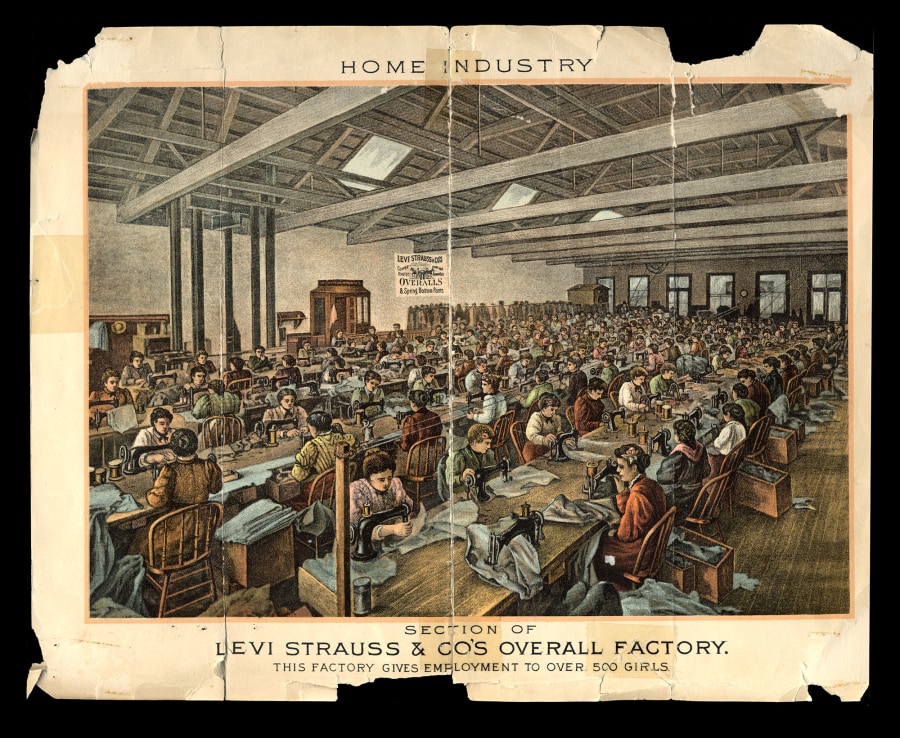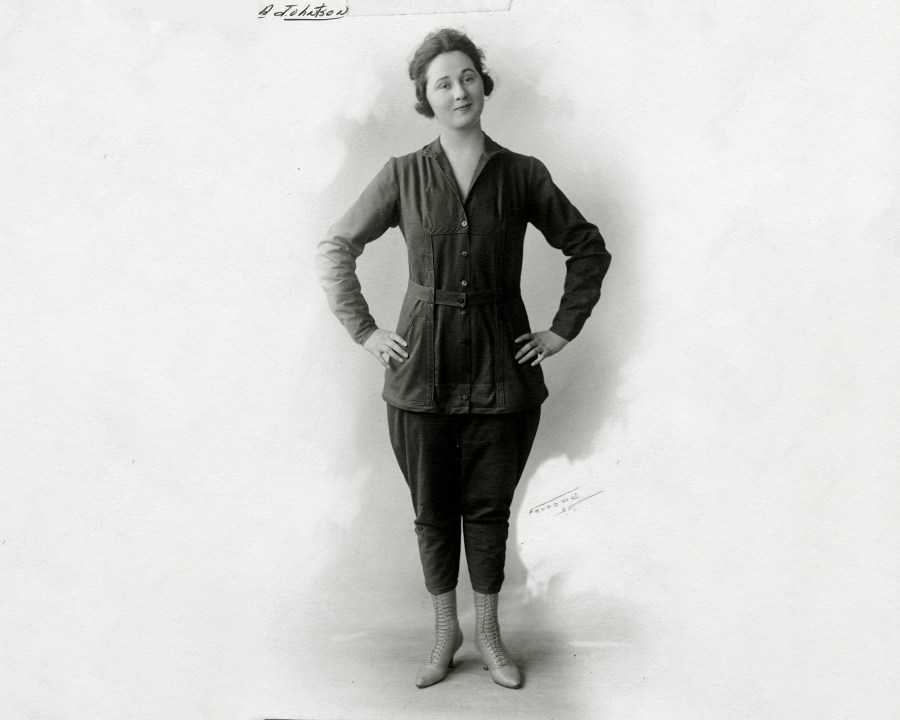
Levi Strauss & Co. Archives
Today, jeans are ubiquitous for all genders—from the bootcut to the jegging, most in the western world don’t bat an eye at a woman wearing jeans. But widespread acceptance of women in jeans is a comparatively recent sartorial development; not so long ago, women wearing pants was virtually unheard of. This International Women’s Day, we’re continuing our exploration into the world of denim with a crash course in the herstory of the blue jean—from controversial irregularity to symbol of female empowerment.
The first jeans for women were made by Levi Strauss & Co. in 1934, but the story of women and jeans begins much earlier than that. Women were pushing to bring any pants into mainstream women’s fashion as early as the nineteenth century. Meanwhile, although not yet wearing their own pants, women were taking on a central role in developing a new type of clothing: the blue jean. When Levi Strauss & Co. first began mass-producing riveted pants in 1873, the company hired as many sewing machine operators as possible, most of whom were women. These seamstresses sewed nearly all of the company’s clothing for decades, while men took on the factory’s support roles (roles which to this day are often automatically ascribed to women). One image in Levi Strauss: A History of American Style highlights the high demand for seamstresses with signage reading “Female Help Wanted, Sewing Machine Operators, on Overalls, Jumpers, and Coats.”

Levi Strauss & Co. Archives
The next iteration of women’s pants surfaced during World War I, when many women took over jobs traditionally held by men. With this development came a need for more work-ready apparel, and Levi Strauss & Co. responded with a new one-piece garment called Freedom-Alls. These fulfilled the needs of both traditional dress and progressive ideals, offering the mobility of pants while remaining loose and stylistically reminiscent of skirts. Freedom-Alls also played off of the liberty language surrounding the war—while, intentionally or not, taking on a second meaning calling for women’s liberation and freedom of style.

Levi Strauss & Co. Archives
Some women jumped aboard the Freedom-Alls train (including one who wore them as her wedding ensemble), but they ultimately didn’t catch on. Luckily, Levi’s® didn’t give up on womenswear. In 1934, the first jeans made specifically for women hit the scene: Lady Levi’s®. A key moment in the history of women’s pants, these were marketed as a leisure garment for women vacationing at dude ranches, aligning with Levi’s® adoption of the cowboy and American West as defining symbols of their brand throughout the mid-1900s. They weren’t yet accepted as everyday wear, but Lady Levi’s® do mark the first inclusion of jeans in women’s fashion for leisure rather than work. The name "Freedom-Alls" also played off of the liberty language surrounding the war, while simultaneously aligning with the women’s suffrage movement as a call for women’s liberation and freedom of style.

Levi Strauss & Co. Archives
Throughout the 1930s and 40s, women wearing pants of any kind, let alone denim, were still seen as edgy at best and inappropriate at worst. But as the counterculture, civil rights, and women’s liberation movements of the 1960s and 70s gained momentum, this began to shift. Women started to take ownership of jeans as symbols of empowerment, and in 1968, Levi’s® created their womenswear division—then called “Levi’s® for Gals.” The world of high fashion began adopting the trend, too; Yves Saint Laurent (who also decorated one of the denim Levi’s® jackets in the exhibition) is widely credited with helping pave the way for women’s pants as a bold but acceptable trend in high fashion with his designs for women’s suits.
Women continued to embrace blue jeans throughout the late twentieth century (and beyond). Many of the ensembles on view in Levi Strauss: A History of American Style are notable outfits worn by female pop culture icons of this time who incorporated denim as definitive elements of their style; Madonna’s cutoff shorts, Lauryn Hill’s denim patchwork shirt, and Beyoncé’s Superlows, to name a few. Levi’s® womenswear has grown along with the women’s movement—from Levi’s® for Gals to today’s Jeans for Women—and continues to champion women’s grassroots organizations and empowerment efforts worldwide.
To conclude our journey through the story of women’s denim, it’s fitting to remember that women have played indispensable roles in the creation of blue jeans from the beginning—from Rebekka Strauss’s decision to move to America with her family to the women who created the first mass-produced riveted pants in Levi Strauss & Co.’s Valencia Street factory. As Stacia Fink, a current Levi Strauss & Co. conservator, said, “I applaud the women who worked with denim. [It’s] like iron—so tough to work with.”
Here’s to continuing the ironwork, whether we’re stitching up denim or challenging the patriarchy!

Lucy Sims is the Editorial Coordinator at The Contemporary Jewish Museum (The CJM), where she works to ensure that The Museum's content is as engaging, effective, and error-free as possible. Sims graduated summa cum laude from the University of California, Santa Barbara with a degree in English and religious studies, and is passionate about writing, art, and creative expression of all kinds. She is also a tea enthusiast, music-lover, and proponent of Oxford commas.